Maldon walk - Northern mines
Eagle Hawk district, Union Hill mine, Battery, Alliance mine, Railway and Beehive <2 km walk
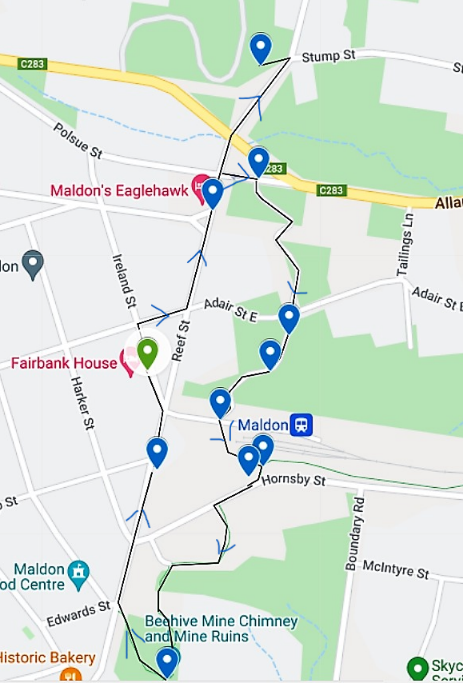 Parks Victoria's Maldon trail extends from the Eaglehawk precinct with its Union hill mine to the South German mine as the town area of the four-kilometre north-south gold field. The northern mines walk begins at the Reef Street entrance to the Beehive chimney, winds through the German Gully diggings, over the railway and across the Alliance mine complex to the Union Hill mine at Eagle Hawk Gully. Volunteer Lee Mead & oths. produced a three-walk Maldon mines pamphlet, available at the Shire's Visitors Information Centres, and this Wander expands on their work.
Parks Victoria's Maldon trail extends from the Eaglehawk precinct with its Union hill mine to the South German mine as the town area of the four-kilometre north-south gold field. The northern mines walk begins at the Reef Street entrance to the Beehive chimney, winds through the German Gully diggings, over the railway and across the Alliance mine complex to the Union Hill mine at Eagle Hawk Gully. Volunteer Lee Mead & oths. produced a three-walk Maldon mines pamphlet, available at the Shire's Visitors Information Centres, and this Wander expands on their work.
From 1855, a one pound per year Miner's Right would allow occupation of a quarter-acre mining allotment and erection of accommodation, hence Maldon's complex and notorious land titles. Given the issues on the goldfield that renamed German Gully Growlers Gully (Boundary Road side), thousands of diggers with their new miner's right prospected surface gold to about 10 metres deep, most following the news of a new rush after a few months and abandoning their leases. By the late 1850s, it was necessary to bring in heavy machinery to exploit the reefs; the first Beehive company was formed in 1859 to raise such funds. Maldon goldminers, true to their Victorian ethos, were trend setters and used the latest equipment (rock drilling) and gold extraction (cyaniding) to maximise gold production, Over time, Maldon’s companies recorded output of 54,430 kg of gold (today, $70,000 per kg). Actual gold takings for the field above and beyond official figures, is anyone’s guess. Goldmining in one form or another is part of Maldon’s fabric - the hills to the north of town aren't called Nuggetty after shoe polish.
By 1860, the Beehive Quartz-Mining Association (known later as the Old Beehive Company), backed by 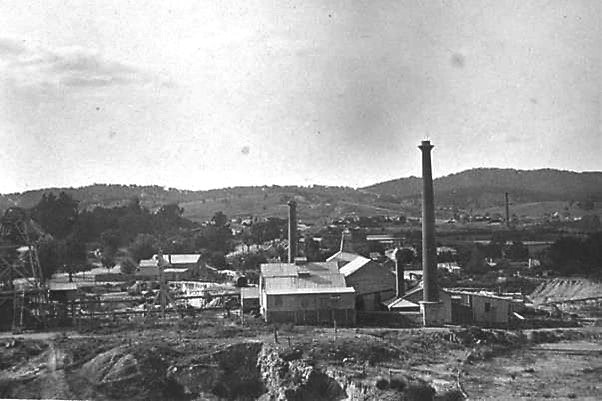 considerable funding, had ‘the most powerful (steam) engine in Victoria’ at 60 horsepower and running a 24-stamp head battery to crush the quartz for gold extraction. Unusually, the Beehive's enginehouse was located 60m from its shaft; usually the power source for running cages up and down hundreds of metres was set next to the long axis of a mine's shaft. Nevertheless, 1865 was the peak of the Old Beehive’s glory days - up to 12.5kg per tonne of rock - although its neighbour to the south, the Great Western Company, picked up the remaining Beehive’s lode when it was cut off by a dyke, or shift in the earth's crust, to appear again lower down and on Great Western's lease.
considerable funding, had ‘the most powerful (steam) engine in Victoria’ at 60 horsepower and running a 24-stamp head battery to crush the quartz for gold extraction. Unusually, the Beehive's enginehouse was located 60m from its shaft; usually the power source for running cages up and down hundreds of metres was set next to the long axis of a mine's shaft. Nevertheless, 1865 was the peak of the Old Beehive’s glory days - up to 12.5kg per tonne of rock - although its neighbour to the south, the Great Western Company, picked up the remaining Beehive’s lode when it was cut off by a dyke, or shift in the earth's crust, to appear again lower down and on Great Western's lease.
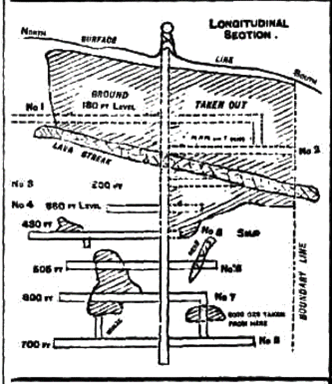
The New Beehive Company was financed in 1880 (using public offering material such as this drawing), encouraged by the ‘colour’ at 34g per tonne at the 160m level in the old shaft (Kalgoorlie mines operate at one tenth of that gold content). The missing lode appeared again 20m west (under Reef St) in December, 1883 at 45g per tonne; and another, larger pocket of gold-bearing rock appeared in 1885. The main vertical shaft eventually reached 400m in depth. But water infiltration, gold-bearing rock scarcity , and other Australian goldfields opening up eventually took their toll. The adjacent mines to the Beehive were amalgamated as the Derby United Company about 1904 and were intermittently worked until 1918. Officially, 6.5 tonnes of gold was produced by successive mining companies from the Beehive-Derby precinct, but this doesn't include the 'tributors' - sub-leases by mining companies for about 25 per cent of the gold found.
Following the path from the street, the original shaft is to the right, fenced off. The ruins around the chimney and across the site are the stone and brick substructures for batteries, steam engines and administration/crib rooms, representing generations of buildings and the processes used to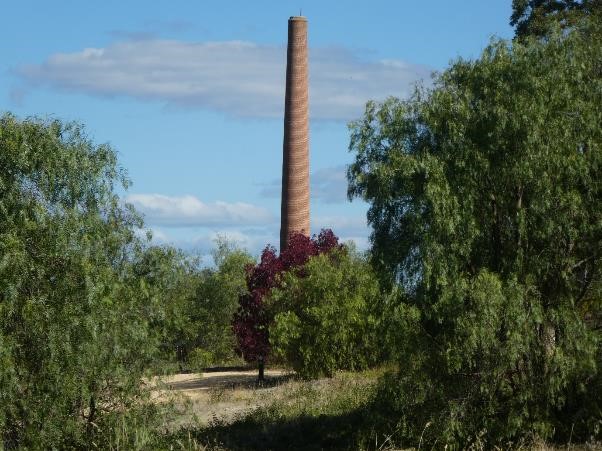 extract the gold.
extract the gold.
This chimney was completed in 1863 using curved bricks and stood over 30 metres high, It was purchased in 1918 by the Maldon Progress Association as an icon of the town, but the top was lost by lightning in 1923 and eventually repaired in 1974. The settling ponds crossed by the pathway similarly functioned for later chemical leaching for gold, and there were chemical vats further down German Gully under the vegetation.
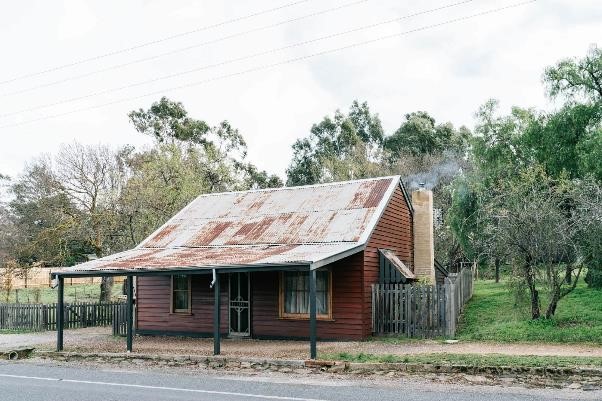 Following the Parks' trail east through the Diggings across Hornsby St to the railway station, you pass under the verandah of Shopkeeper’s Quarters, 11 Hornsby St, In the early 20th century it was a shop owned by a fruitier, Daniel Aust. It has a marvellous view across the Diggings towards Daylesford to the southeast. Daniel’s customers were passers-by; train passengers and those using the Bendigo road, but it fell out of use when the rail passenger services were dropped in the 1940s, The building became derelict until recently restored for short term accommodation from Maldon Getaways. https://www.maldongetaways.com.au/en/1045362/shopkeepers-quarters-maldon
Following the Parks' trail east through the Diggings across Hornsby St to the railway station, you pass under the verandah of Shopkeeper’s Quarters, 11 Hornsby St, In the early 20th century it was a shop owned by a fruitier, Daniel Aust. It has a marvellous view across the Diggings towards Daylesford to the southeast. Daniel’s customers were passers-by; train passengers and those using the Bendigo road, but it fell out of use when the rail passenger services were dropped in the 1940s, The building became derelict until recently restored for short term accommodation from Maldon Getaways. https://www.maldongetaways.com.au/en/1045362/shopkeepers-quarters-maldon
The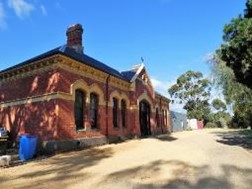 Maldon Railway Station was opened in 1884, serving a population
Maldon Railway Station was opened in 1884, serving a population 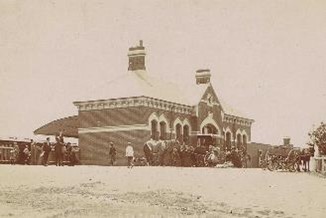 about double the current 1500, but then numbers declined as the gold finds dwindled and it reverted to a goods service In 1986 the station was taken over by the Victorian Goldfields Railway and the line was progressively reopened to its former junction point at Castlemaine between 1986 and its official opening in 2005. It's been chuffing along ever since.
about double the current 1500, but then numbers declined as the gold finds dwindled and it reverted to a goods service In 1986 the station was taken over by the Victorian Goldfields Railway and the line was progressively reopened to its former junction point at Castlemaine between 1986 and its official opening in 2005. It's been chuffing along ever since.
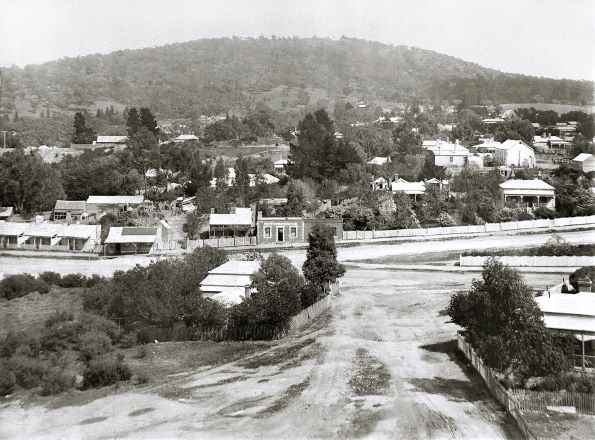
Follow the trail across the railway yards and pick it up a few metres to the north up the embankment, part of the Linscotts-Eaglehawk-Alliance. Take in the view from one of the park benches along the track and admire the Alliance shaft under the peppercorn tree. Here's Ireland St from the poppet head in 1910. Fairbank's on the right.
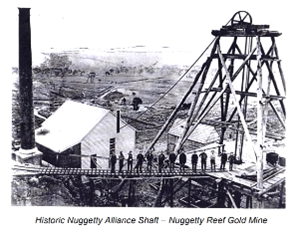 This is the Alliance precinct which was worked from 1857 until 1880 by the Eaglehawk Association, the Central Eaglehawk, the Central Extended and the Alliance companies. These companies contributed to several shafts around their respective parts of the 25 hectare lease, mainly three large shafts suitable for machinery. The Alliance Eaglehawk Company took over the lease in 1880 and started operations in March using the three shafts (180m, 190m, 235m), found water in June, and then gold in December. Within a year they had tunnelled north, then south, from the Alliance’s 235m shaft, finding a gold bearing reef 2m wide along the length of 60m. This success led to building their own battery of 24 stamp-heads with a capacity of 200 tonnes of stone per week and in 1885 the battery was stamping stone from both quartz and alluvial miners as well. In 1890, the Eaglehawk Alliance lease had produced 9.7 tonnes of gold. Underlining the inherent dangers of the industry, in September 1895 the steam boiler at the Alliance battery exploded, causing a fatality of a Chinese miner.
This is the Alliance precinct which was worked from 1857 until 1880 by the Eaglehawk Association, the Central Eaglehawk, the Central Extended and the Alliance companies. These companies contributed to several shafts around their respective parts of the 25 hectare lease, mainly three large shafts suitable for machinery. The Alliance Eaglehawk Company took over the lease in 1880 and started operations in March using the three shafts (180m, 190m, 235m), found water in June, and then gold in December. Within a year they had tunnelled north, then south, from the Alliance’s 235m shaft, finding a gold bearing reef 2m wide along the length of 60m. This success led to building their own battery of 24 stamp-heads with a capacity of 200 tonnes of stone per week and in 1885 the battery was stamping stone from both quartz and alluvial miners as well. In 1890, the Eaglehawk Alliance lease had produced 9.7 tonnes of gold. Underlining the inherent dangers of the industry, in September 1895 the steam boiler at the Alliance battery exploded, causing a fatality of a Chinese miner.
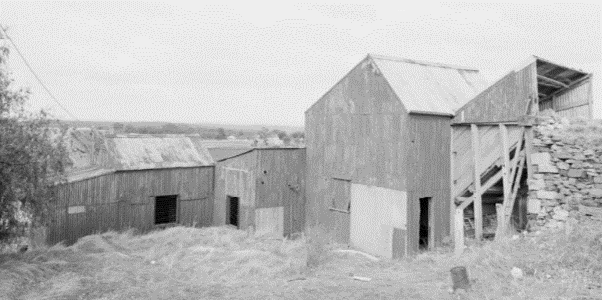 Maldon State Battery was built in 1914 to service smaller mines and operated on demand for the quartz miners. It has two buildings: a larger corrugated iron shed and a smaller furnace shed. To the east of the furnace shed are 5 U-shaped concrete draining bays filled with tailings. Further down the hill was a large 50 m wide, 15 m high, dump of treated tailings, although this is significantly diminished, used for fill and gardens by Maldon residents over the years. The battery was still operating in 1992, serving the miners around the Nuggettys and possibly on Mt. Tarrengower.
Maldon State Battery was built in 1914 to service smaller mines and operated on demand for the quartz miners. It has two buildings: a larger corrugated iron shed and a smaller furnace shed. To the east of the furnace shed are 5 U-shaped concrete draining bays filled with tailings. Further down the hill was a large 50 m wide, 15 m high, dump of treated tailings, although this is significantly diminished, used for fill and gardens by Maldon residents over the years. The battery was still operating in 1992, serving the miners around the Nuggettys and possibly on Mt. Tarrengower.
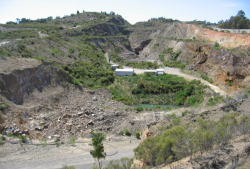 Continuing north across Adair St. East, the Parks Victoria trail traverses reclaimed and revegetated land from exploratory drilling about 2000, earlier site of Courtin's baths (see under). The trail emerges on Allan’s Road and is then picked up again as a carpark on Reef Street about 100m past Lowther Street. This is the lookout for the Union Hill mine, operated currently by Kaiser Reef. Their lease includes the rich Nuggetty mine on the hill above which produced 8.5 tonnes of gold at an average 187g. per tonne a century past (Kaiser Reef, 2021). Union Hill itself produced some 930 kig of gold just in the 1990s. In all, the Nuggetty part of the Linscott’s/Eaglehawk reefs produced 13.9 tonnes of gold and the Union Hill adit reaches some 380 metres deep.
Continuing north across Adair St. East, the Parks Victoria trail traverses reclaimed and revegetated land from exploratory drilling about 2000, earlier site of Courtin's baths (see under). The trail emerges on Allan’s Road and is then picked up again as a carpark on Reef Street about 100m past Lowther Street. This is the lookout for the Union Hill mine, operated currently by Kaiser Reef. Their lease includes the rich Nuggetty mine on the hill above which produced 8.5 tonnes of gold at an average 187g. per tonne a century past (Kaiser Reef, 2021). Union Hill itself produced some 930 kig of gold just in the 1990s. In all, the Nuggetty part of the Linscott’s/Eaglehawk reefs produced 13.9 tonnes of gold and the Union Hill adit reaches some 380 metres deep.
B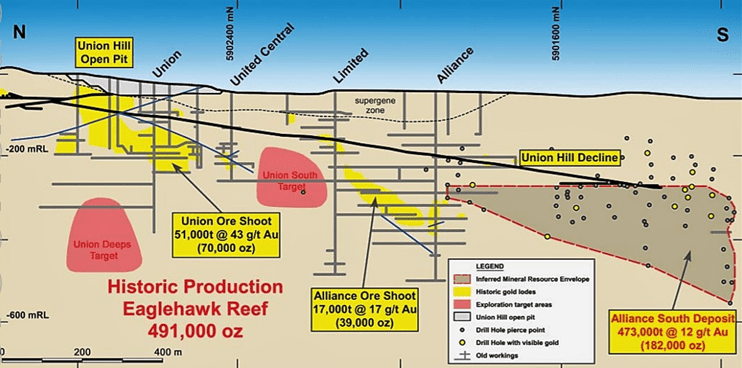 etween 1988 and 1992, an open cut mine operated here. In 1995, underground mining recommenced when a 3 x 3m adit was dug using some of the original tunnels. The adit can be seen from the lookout platform and runs from here under the Maldon Diggings to Phoenix St. Over Maldon's heyday, Eaglehawk Gully produced alluvial and reef gold, from the Linscott/Eaglehawk/ Alliance reef. The principal mine was Eaglehawk Union or Union Association (5.5 tonnes of gold), then United Central, Eaglehawk Limited, South Eaglehawk, Bells Reef to the east and Alliance to the south. By 1876, these were Linscott, Eaglehawk United and Eaglehawk Union with Alliance’s production fading at the south end.
etween 1988 and 1992, an open cut mine operated here. In 1995, underground mining recommenced when a 3 x 3m adit was dug using some of the original tunnels. The adit can be seen from the lookout platform and runs from here under the Maldon Diggings to Phoenix St. Over Maldon's heyday, Eaglehawk Gully produced alluvial and reef gold, from the Linscott/Eaglehawk/ Alliance reef. The principal mine was Eaglehawk Union or Union Association (5.5 tonnes of gold), then United Central, Eaglehawk Limited, South Eaglehawk, Bells Reef to the east and Alliance to the south. By 1876, these were Linscott, Eaglehawk United and Eaglehawk Union with Alliance’s production fading at the south end. 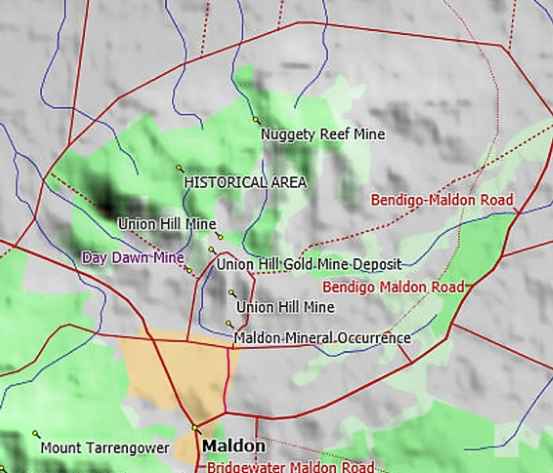
Apart from Union Hill mine itself, there's not much remaining of the 19th century mining infrastructure, due to intermittent mining. For example, the Eaglehawk Union company constructed two large quartz kilns in 1861, similar to those of the Caledonian Battery south on High Street. These were demolished by Triad Minerals in the early 1990s to facilitate unsuccessful strip mining. Then Alliance Resources bought the lease from Triad Minerals (including Porcupine Flat gold processing) in 1994 and sold its Maldon sites for scrip to Octagonal Resources in 2010. Octagonal folded in 2016, and the assets were purchased by Centennial Mining (delisted), finally bought by Kaiser Reef in 2021 for $7.5m. Following those ownership trails from 1858 to Triad’s ownership should keep a forensic researcher occupied for years.
Water was a problem for all early Maldon mines, either insufficient during drought times (and late summer)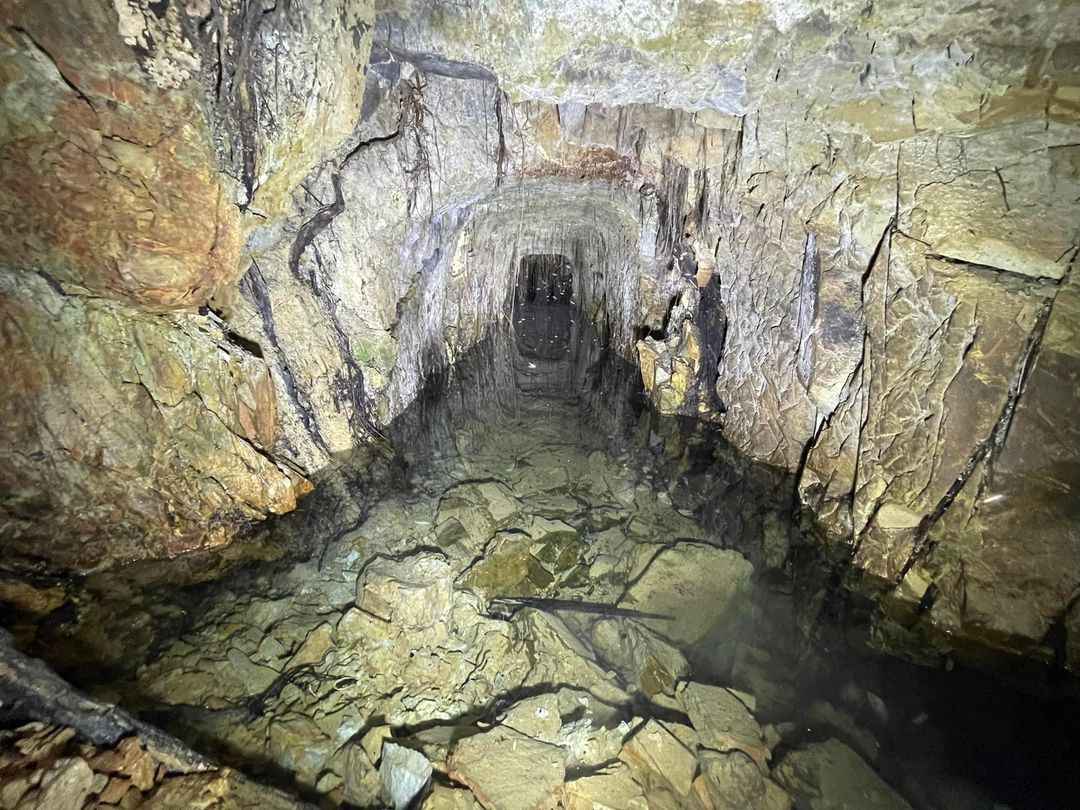 for gold processing, or seepage flooding galleries below about 100 metres for the Eaglehawk reef. A great many of our (Maldon’s) engines are idle and the water is rising. The Linscott’s, Eaglehawk United, and Eaglehawk Union Companies have now to battle with the whole of the water along the Eaglehawk and Linscott’s lines of reef, and they find it an expensive item to deal with (Bannear 1993). Seepage continues: a pipe runs alongside the railway and crosses under Hornsby St near the station, flowing (sometimes) into Growlers Gully. It reportedly comes from the Nuggettys’ old mines, presumable Union Hill. This picture from the Victorian Historical Mine Shaft Chasers at Daylesford, so someone's still benefitting from the mines.
for gold processing, or seepage flooding galleries below about 100 metres for the Eaglehawk reef. A great many of our (Maldon’s) engines are idle and the water is rising. The Linscott’s, Eaglehawk United, and Eaglehawk Union Companies have now to battle with the whole of the water along the Eaglehawk and Linscott’s lines of reef, and they find it an expensive item to deal with (Bannear 1993). Seepage continues: a pipe runs alongside the railway and crosses under Hornsby St near the station, flowing (sometimes) into Growlers Gully. It reportedly comes from the Nuggettys’ old mines, presumable Union Hill. This picture from the Victorian Historical Mine Shaft Chasers at Daylesford, so someone's still benefitting from the mines.
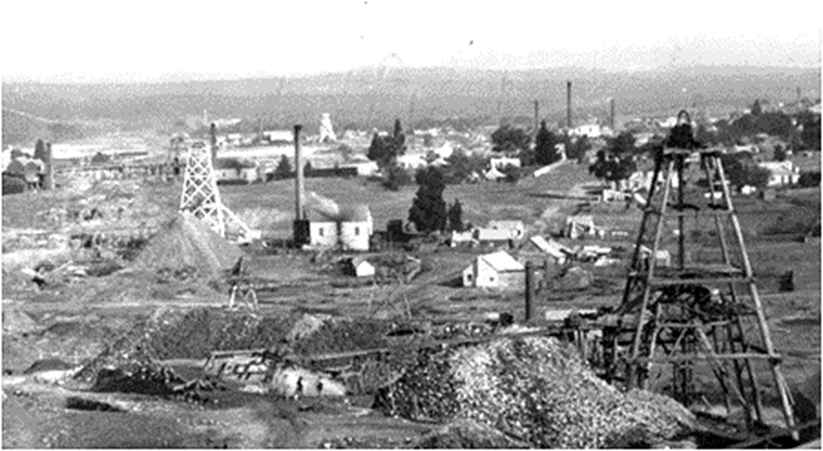
Returning to Lee Mead’s account, Reef Street was originally Eagle Hawk Road, a business area in 1864 of 25 businesses: shops, professional offices and of course mines. The Eagle Hawk neighbourhood also had a school, churches and a synagogue, a Chinese pub, and a German club or vereine . This picture is from a poppethead, looking south at busy Maldon.
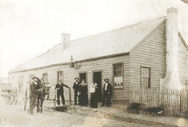 Retracing the trail south on Reef Street, the 1854 Eaglehawk hotel iwas purchased in 1862 by Frederic Courtin, a Maldon mayor and leader of the German community. His establishment had 11 bedrooms, a bagatelle room, concert hall and stables. Prior to his purchase, Herr Courtin opened the Tarrangower Bathing Company’s public baths in 1860, conveniently opposite the hotel on land now part of Parks Victoria's trail. In a neat recycling plan, the baths used abundant pumped mine water to fill a 27m x 18m pool ranging from a metre to 2m in depth. There were screened areas for women, but no record of any heating, so it may have been a summer sport.
Retracing the trail south on Reef Street, the 1854 Eaglehawk hotel iwas purchased in 1862 by Frederic Courtin, a Maldon mayor and leader of the German community. His establishment had 11 bedrooms, a bagatelle room, concert hall and stables. Prior to his purchase, Herr Courtin opened the Tarrangower Bathing Company’s public baths in 1860, conveniently opposite the hotel on land now part of Parks Victoria's trail. In a neat recycling plan, the baths used abundant pumped mine water to fill a 27m x 18m pool ranging from a metre to 2m in depth. There were screened areas for women, but no record of any heating, so it may have been a summer sport.
Building materials for the Goldfields were costly imports. lightweight and portable wooden panels and 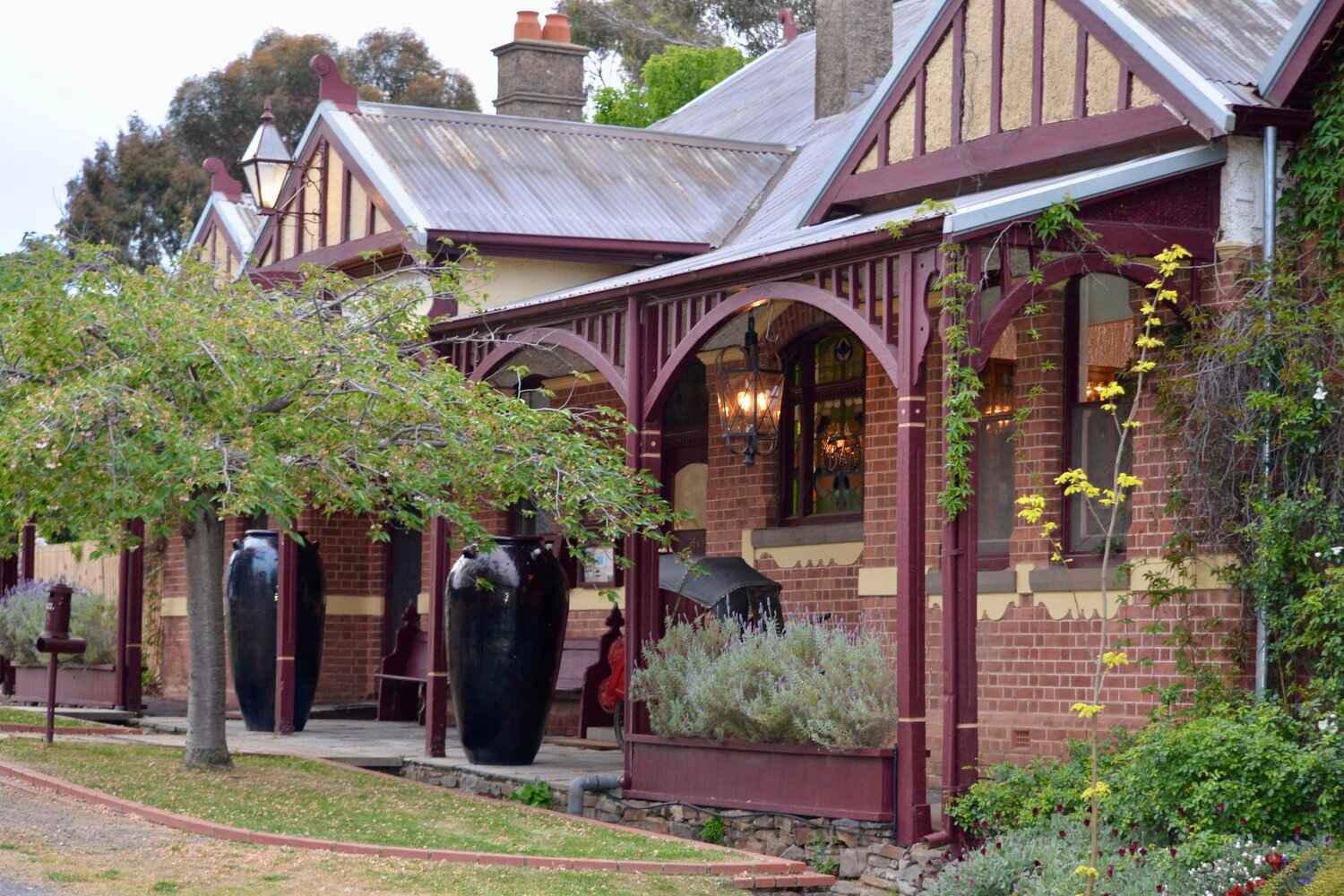 sheet iron, that could be readily moved to follow the rushes. Local bricks and lumber were available, but it took decades to establish the manufacturing environment to fufil the colony's accommodation needs. But by 1906, when Courtin's public house burnt down, the Eagle Hawk district could boast a grand Federation style replacement to welcome its thirsty miners. A motel was added in the 1980s, Maldon’s Eaglehawk Motel, https://www.maldoneaglehawk.com, changing owners in 2021 . The main building is a different business, a country holiday house and a bespoke wedding venue, and is very popular as such – www.eaglehawkhotelmaldon.com.au.
sheet iron, that could be readily moved to follow the rushes. Local bricks and lumber were available, but it took decades to establish the manufacturing environment to fufil the colony's accommodation needs. But by 1906, when Courtin's public house burnt down, the Eagle Hawk district could boast a grand Federation style replacement to welcome its thirsty miners. A motel was added in the 1980s, Maldon’s Eaglehawk Motel, https://www.maldoneaglehawk.com, changing owners in 2021 . The main building is a different business, a country holiday house and a bespoke wedding venue, and is very popular as such – www.eaglehawkhotelmaldon.com.au.
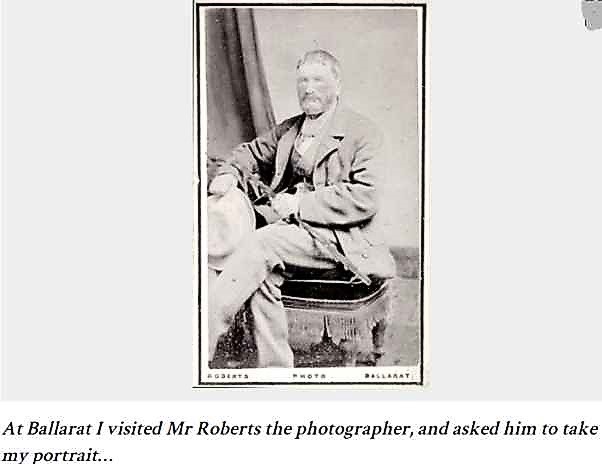 Continuing south, the street crosses part of the mullock heap from the Alliance mine, site of a refurbished farmhouse at 21B Reef St - Maldon has an idiosyncratic street address system. Other houses of the miner’s cottage vernacular are hidden by vegetation on the east side, and Fairbank House is on Ireland St to the west. Passing the railway yards and the water tower at the Camp Street crossing you arrive at Joe Jenkins’ place.
Continuing south, the street crosses part of the mullock heap from the Alliance mine, site of a refurbished farmhouse at 21B Reef St - Maldon has an idiosyncratic street address system. Other houses of the miner’s cottage vernacular are hidden by vegetation on the east side, and Fairbank House is on Ireland St to the west. Passing the railway yards and the water tower at the Camp Street crossing you arrive at Joe Jenkins’ place.
The Diary of a Welsh Swagman chronicles the daily life of Joseph Jenkins (1818-1898). an itinerant writer, who in 1869 at the age of 51 left his family and struck out for the Antipodes. A poet and writer, Joe travelled the bush of Victoria until he landed a job with the Maldon Council, stayed 25 years, and then returned to Wales. As you do.
This finishes the forensic investigatory walk. Wander into town to plan your next book on the characters of Maldon, past, present, and future.
